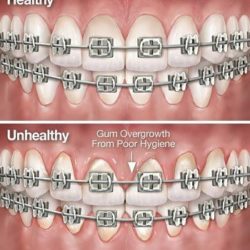After your child receives braces to correct a poor bite, you may notice that the gums are swelling and turning red. These are symptoms of the mild or less serious version of periodontal disease referred to as gingivitis. Gum disease is an oral infection that occurs after plaque is not properly removed from the teeth through daily brushing and flossing. Sometimes, braces can increase the risk of developing gingivitis.
How Braces Affect Gum Health
Braces are made of plastic or metal brackets fitted on the teeth and joined together using metal bands. The hardware makes it difficult to clean areas of the kid’s teeth with floss string or brush. As a result, plaque may be left behind, which in turn, triggers an infection, causing swelling or inflammation and bleeding. To make matters worse, gums do not always respond well to braces; they can react by overgrowing. Additionally, the time a child receives braces may coincide with their surge in hormones, often accelerating the infection. If not treated, gingivitis can advance to more serious phases of the disease, eventually causing tooth loss.
How to Prevent Gingivitis While you Wear Braces
 Your kid can prevent gingivitis by ensuring proper daily oral hygiene. The kid should take more time to sufficiently reach all tooth surfaces with their brush and floss. You can get them a motorized toothbrush or one that can work around braces. When it comes to flossing, there are special threaders designed for people with braces that can get around braces wires.
Your kid can prevent gingivitis by ensuring proper daily oral hygiene. The kid should take more time to sufficiently reach all tooth surfaces with their brush and floss. You can get them a motorized toothbrush or one that can work around braces. When it comes to flossing, there are special threaders designed for people with braces that can get around braces wires.
A water flosser is also suitable for removing plaque as it applies a pulsating water stream to wash down the debris. It is also paramount that the kid sees our periodontist regularly while wearing braces to get them monitored and receive treatment for overgrowths. The periodontist will also perform dental cleanings and if gingivitis has set in, treatment is offered. Request an appointment with our dental team to receive braces or get treatment for gingivitis that is occurring from wearing braces.

